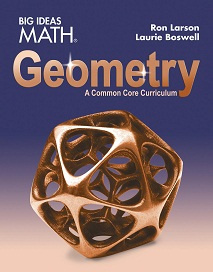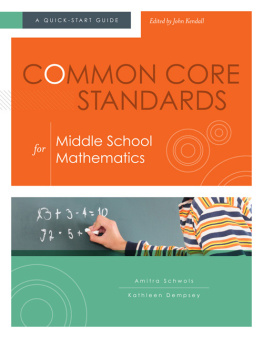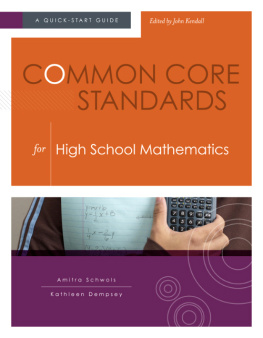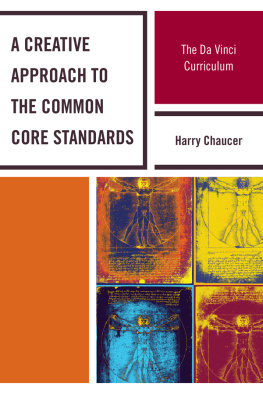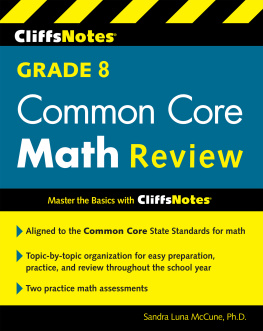Contents
Big Ideas Learning, LLC 1762 Norcross Road Erie, P A 16510-3838 USA For product information and customer support, contact Big Ideas Learning at 1-877-552-7766 or visit us at BigIdeasLearning.com . Cover Image Image of metal sculpture by Vladimir Bulato v Copyright 2015 b y Big Idea s Learning, LLC. All rights re served. No part of this work may be re produced or tra nsmitted in any form or by any means, electronic or mechanical, including, but not limited to , p hotocopying and re cording, or by any informati on storage or re trieval system, without prior wr itten permission of Big Ideas Le arning, LLC unless such copying is expre ssly permitted by copyrig ht law. Address inquiries to Permissions, Big Ideas Le arning, LLC, 1762 Nor cross Ro ad, Erie, P A 16510. Big Ideas Learning and Big Ideas Math are reg istered tra demarks of Larson T ex ts, Inc. Common Core Sta te Standards: Copyright 2010. N ational Governors Association Cen ter for Best Practices and Council of Chief Sta te School O c ers. All righ ts reserv ed. Printed in the U .S .A. ISB N 13: 978-1-60840-839-9 ISB N 10: 1-60840-839-6 8 10 WEB 18 17 16 15
iii Dr. Ron Larson and Dr. Laurie Boswell began writing together in 1992. Since that time, they have authored over three dozen textbooks. In their collaboration, Ron is primarily responsible for the Student Edition while Laurie is primarily responsible for the Teaching Edition. Ron Larson, Ph.D. , is well known as the lead author of a comprehensive program for mathematics that spans middle school, high school, and college courses. He holds the distinction of Professor Emeritus from Penn State Erie, The Behrend College, where he taught for nearly 40 years. He received his Ph.D. in mathematics from the University of Colorado. Dr . Larson s numerous professional activities keep him actively involved in the mathematics education community and allow him to fully understand the needs of students, teachers, supervisors, and administrators. Laurie Boswell, Ed.D. , is the Head of School and a mathematics teacher at the Riverside School in L yndonville, V ermont. Dr . Boswell is a recipient of the Presidential A ward for Excellence in Mathematics T eaching and has taught mathematics to students at all levels, from elementary through college. Dr . Boswell is a T andy T echnology Scholar and served on the NCTM Board of Directors from 2002 to 2005. She currently serves on the board of NCSM and is a popular national speaker . Authors
iv Tr ansformations Maintainin g Mathematical Prof iciency Maintainin g Mathematical Prof iciency Identify ing T ra nsformations Example 1 T e ll whether the red figure is a tr anslation, ref lection, rotation, or dilation of the blue figure . a. The blue gure b. The red gure is a turns to form mirror image of the the red gure, blue gure, so it is so it is a rotation. a re ection. Tel l whether the red figure is a tra nslation, reflection, rotat ion, or dilation of the blue figure. Identify ing Similar Figures Example 2 W hich r ectangle is similar to Rectangle A? Rectangle A Rectangle B Rectangle C Each figure is a rectangle, so corresponding angles are congruent. Check to see whether corresponding side lengths are proportional. Rectangle A and Rectangle B Rectangle A and Rectangle C Length of A Length of B = = W idth of A Widt h of B = = Length of A Length of C = = W idth of A Widt h of C = not proportional proportional So, Rectangle C is similar to Rectangle A. Tel l whether the two figures are simi lar. Explain your reasoning. ABSTRACT REASONING Can you draw two squares that are not similar? Explain your reasoning. 4.1 Tra nslations 4.2 Reflect ions 4.3 Rotation s 4.4 Congruence and Tr ansfor mations 4.5 Dilations 4.6 Similari ty and T ra nsform ations Revolving D oor (p. 19 5) Kaleidoscope (p. 19 6) Magnification (p. 21 3) Chess (p. 17 9) Ma gn ificatio n (p . 213) Kaleid oscope (p ) Re vo lvin g Do or (p 95) SEE the Big Idea SEE the Big Idea Ch ess (p . 9) Photo Stick ers (p. 21 1) Ph ot o St icke rs (p . 1) Dynamic Solutions available at BigIdeasMath.c om pg g p p Chapter 4 Tr ansformati ons Mathematical Mathematical Practice s Practice s Using Dynamic Geometry Softwa re Mathematically pr o cient students use dynamic g eometry softwar e str ate gically . Monitoring Progress Use dynamic geometry software to draw the polygon with the gi ven vertice s. Use the software to nd the side lengths and angle measur es of the polygon. Round y our answers to the nearest hundr edth. A (0, 2), B (3, 1), C (4, 3) A ( 2, 1), B ( 2, 1), C (3, 2) A (1, 1), B ( 3, 1), C ( 3, 2), D (1, 2) A (1, 1), B ( 3, 1), C ( 2, 2), D (2, 2) A ( 3, 0), B (0, 3), C (3, 0), D (0, 3) A (0, 0), B (4, 0), C (1, 1), D (0, 3) F inding Side Lengths and Angle Measures Use dynamic geometry software to draw a triangle with vertices at A ( 2, 1), B (2, 1), and C (2, 2). Find the side lengths and angle measures of the triangle. SOLUTION Using dynamic geometry software, you can create ABC , as show n. AB C From the display , the side lengths are AB = 4 units, BC = 3 units, and AC = 5 units. The angle measures, rounded to two decimal places, are m A 36.87 , m B = , and m C 53.13 . Using Dynami c Geometry Soft ware Dynamic geometry software allo ws you to create geometric drawings, including: dra wing a point dra wing a line dra wing a line se gment dra wing an angle measuring an angle measuring a line se gment dra wing a circle dra wing an ellipse dra wing a perpendicular line dra wing a polygon cop ying and sliding an object re ecti ng an object in a line Core Core Concept Concept Sample Poi nts A ( 2, 1) B (2, 1) C (2, 2) Segments AB = BC = AC = Angles m A = 36.87 m B = m C = 53.1 Chapter 4 T r ans formations Monitoring Progress Monitoring P o ess Monit i to t oring P ro r og o gre r ess Use dynamic geometry software to draw the polygon with the gi ven vertices . Use the software to nd the side lengths and a ngle measures of the polygon. Round y our answers to the nearest hundr edth. A (0, 2), B (3, 1), C (4, 3) A ( 2, 1), B ( 2, 1), C (3, 2) A (1, 1), B ( 3, 1), C ( 3, 2), D (1, 2) A (1, 1), B ( 3, 1), C ( 2, 2), D (2, 2) A ( 3, 0), B (0, 3), C (3, 0), D (0, 3) A (0, 0), B (4, 0), C (1, 1), D (0, 3) 12 C From th e display , the side lengths are AB = 4 units, BC = 3 units, and AC = 5 units. The angle measures, rounded to two decimal places, are m A 36.87 , m B = , and m C 53.13 . C (2, (, 2) ) Segments AB = BC = AC = Angles m A = 36.87 m B = m C = 53.13 Chapter 4 Tr ansformati ons Section 4.1 T ra nslations Dynamic Solutions available at BigIdeasMath.c om VOCABULARY Name the preimage and image of the transformation ABC A B C . COMPLETE THE S ENTENCE A ______ move s ev ery point of a gure the same distance in the same direction. Exercis es 4. Voca bulary and Core Conce pt Check Voca bulary and Core Conce pt Check In Exercises 3 and 4, name the v ector and write its component form. ( See Example 1.) C D S T In Exercises 5 8, the vertices of DEF are D (2, 5), E (6, 3), and F (4, 0). T ranslate DEF using the given v ector . Graph DEF and its image. ( See Example 2.) 6, 0 5, 3, 2, In Exer cises 9 and 10, nd the component f orm of the vector that translates P ( 3, 6) to P . P (0, 1) P ( 4, 8) In Exer cises 11 and 12, write a rule f or the translation of LMN to L M N . ( See Example 3.) x y N L M N L M 12. N L N L x y M M In Exer cises 13 16, use the translation. ( x , y ) ( x 8, y + 4) What is the image of A (2, 6)? 14. What is the image of B ( 1, 5)? What is the preimage of C ( 3, 10)? What is the preimage of D (4, 3)? In Exercises 1720, graph PQR with vertices P ( 2, 3), Q (1, 2), and R (3, 1) and its image after the translation. ( See Example 4.) ( x , y ) ( x 4, y 6) ( x , y ) ( x 9, y 2) ( x , y ) ( x 2, y 5) ( x , y ) ( x 1, y 3) In Exercises 21 and 22, graph XYZ with vertices X (2, 4), Y (6, 0), and Z (7, 2) and its image after the composition. ( See Example 5.) Tra nslation: ( x , y ) ( x 12, y 4) Tra nslation: ( x , y ) ( x 5, y 9) Tra nslation: ( x , y ) ( x 6, y ) Tra nslation: ( x , y ) ( x 2, y 7) Monitoring Progr ess and Modeling with Mathemati cs Monitoring Progr ess and Modeling with Mathemati cs In Exercises 23 and 24, describe the composition of translations. x y A CB A C B A B C x y D GF E D G E F D F G E ERROR ANAL Y SIS Describe and correct the error in graphing the image of quadrilateral EFGH after the translation ( x , y ) ( x 1, y 2). E H G F G F E H x y MODELING WITH MA THEMA TICS In chess, the knight (the piece shaped like a horse) mov es in an L pattern. The board sho ws tw o consecutiv e move s of a black knight during a game. W rite a composition of translations for the mov es. Th en rew rite the composition as a single translation that mov es the knight from its original position to its ending position. (See Example 6.) 27. PROBLEM SOL VING Yo u are studying an amoeba through a microscope. Suppose the amoeba move s on a grid-indexe d microscope slide in a straight line from square B3 to square G7. ABCDEFGH X a. Describe the translation. b. The side length of each grid square is 2 millimeters. How far does the amoeba trav el? c. The amoeba move s from square B3 to square G7 in 24.5 seconds. W hat is its speed in millimeters per second? MA THEMA TICAL CONNECTIONS T ranslation A maps ( x , y ) to ( x n , y t ). Tr anslation B maps ( x , y ) to ( x s , y m ). a. T ranslate a point using T ranslation A, follo wed by T ranslation B. Write an algebraic rule for the nal image of the point after this composition. b. T ranslate a point using T ranslation B, follo wed by T ranslation A. Write an algebraic rule for the nal image of the point after this composition. c. Compare the rules you wrote for parts (a) and (b). Does it matter which translation you do rst? Explain your reasoning. MA THEMA TICAL CONNECTIONS In Exercises 29 and 30, a translation maps the blue gure to the red gur e. Find the value of each variable. s t r w c b a Section 4.1 T ra nslations Tran slations 4. T ranslating a T riangle in a Coor dinate Plane W ork with a partner . a. Use dynamic geometry software to draw any triangle and label it ABC. b. Copy the triangle and translate (or slide) it to form a ne w gure, called an image , A B C (read as triangle A prime, B prime, C prime). c. What is the relationship between the coordinates of the vertices of ABC and those of A B C ? d. What do you observe about the side lengths and angle measures of the two triangles? 0 12345 A B C A B C Sample Poi nts A ( 1, 2) B (3, 2) C (2, 1) Segments AB = BC = 3.1 AC = 4.24 Angles m A = m B = .57 m C = 63.43 T ranslating a T riangle in a Coor dinate Plane W ork with a partner . a. The point ( x , y ) is translated a units horizontally and b units v ertically . Write a rule to determine the coordinates of the image of ( x , y ). ( x , y ) ( , ) b. Use the rule you wrote in part (a) to translate ABC 4 units left and 3 units dow n. What are the coordinates of the vertices of the image, A B C ? c. Draw A B C . A re its side lengths the same as those of ABC ? Justify your answer . Comparing Angles of T ranslations W ork with a partner . a. In Exploration 2, is ABC a right triangle? Justify your answer . b. In Exploration 2, is A B C a right triangle? Justify your answer . c. Do you think translations always preserv e angle measures? Explain your reasoning. Communicate Yo ur Answe r Communicate Y ou r Answe r Ho w can you translate a gure in a coordinate plane? In Exploration 2, translate A B C 3 units right and 4 units up. W hat are the coordinates of the vertices of the image, A B C ? How are these coordinates related to the coordinates of the vertices of the original triangle, ABC ? Essential Qu estion Essential Que stion Ho w can you translate a gure in a coordinate plane? USING TOOLS STRAT EGICALL Y To be pro cient in math, you need to use appropriate tools strategically , including dynamic geometry software. x y A B C For the Student Welcome to Big Ideas Math Geometry . From start to nish, this program was designed with you, the learner , in mind. As you work through the chapters in your Geometry course, you will be encouraged to think and to make conjectures while you persevere through challenging problems and exercises. You will make errorsand that is ok! Learning and understanding occur when you make errors and push through mental roadblocks to comprehend and solve new and challenging problems. In this program, you will also be required to explain your thinking and your analysis of diverse problems and exercises. Y ou will master content through engaging explorations that will provide deeper understanding, concise stepped-out examples, and rich thought-provoking exercises. Being actively involved in learning will help you develop mathematical reasoning and use it to solve math problems and work through other everyday challenges. W e wish you the best of luck as you explore Geometry . W e are excited to be a part of your preparation for the challenges you will face in the remainder of your high school career and beyond.

